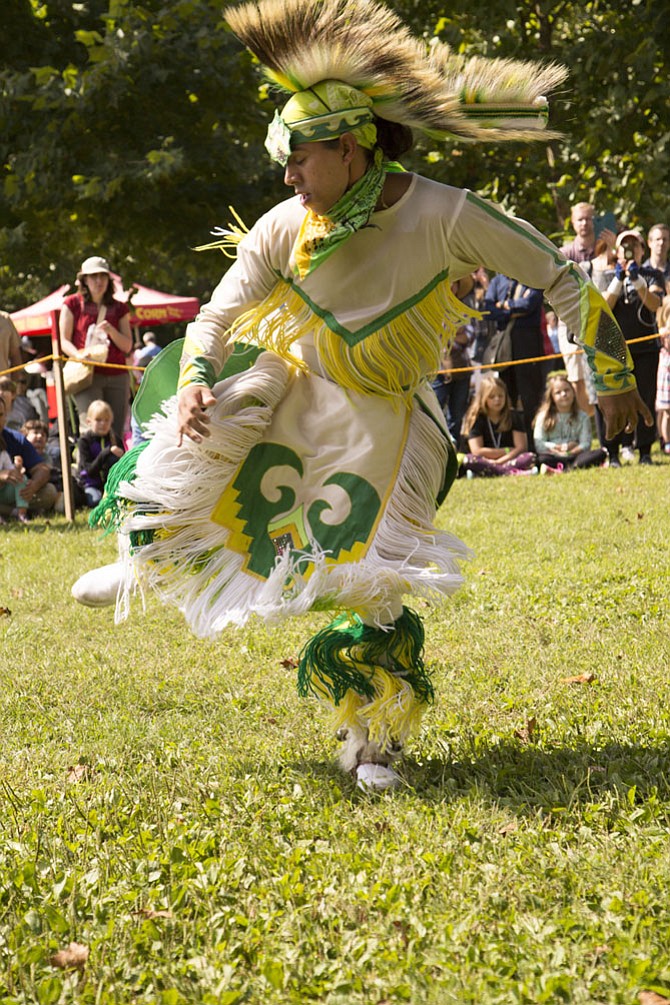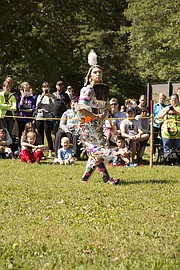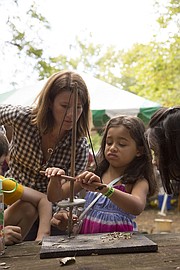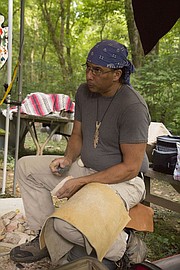Contemporary grass dancer Jacob Fortune performs a “Grass” dance during the powwow. Photo by Fallon Forbush.
Rappahannock Powwow Performers
- Grass Dancer: Jacob Fortune
- Jingle Dress Dancer: Skylar Tilley
- Eastern Woodland Dancer: Reese Fortune
- Traditional Dancers: Angie Miles, Barbara Williams, Faye Fortune, Jerry Fortune, Judith Fortune
- Drummers/Singers: Brian Nelson, Chad Fourbears Fortune, Cochise Fortune and Mark Thunderhawk Fortune.
Indigenous peoples of Virginia and their heritages and cultures were celebrated in Great Falls at the Riverbend Park during the Virginia Indian Festival on Saturday, Sept. 9.
A focal point of the festival was the sacred circle that was roped off on the grass overlooking the Potomac River for the powwow. Dancers from the Rappahannock Tribe Cultural Center in Indian Neck performed seven dances for crowds who gathered around to watch throughout the day.
“I know when the festival is in gear when the Rappahannocks start pounding the drums, and that starts echoing through the trees and through the area and the dancing starts,” said John Callow, Riverbend Park site manager for the Fairfax County Park Authority. “That’s my favorite part — the very first dance that the Rappahannocks do and those drums start pounding. As soon as that happens, you just see all of the visitors flock over to that area to witness it and experience it.”
A large drum made of buffalo hide was beat in unison by four drummers, providing a central pulse for the dancers’ movements.
The powwow began with a parade of the eight dancers, called the “Grand Entry” dance. A “Welcome” dance was performed next, which the Rappahannock people performed when they got together with members of different tribes. A dancing stick was passed around, which was offered and accepted as a form of welcome, Judith Fortune, a traditional dancer with the tribe, told the crowd.
THE FEMALE DANCERS then performed the “Green Corn” dance, which the Rappahannock people performed between summer and fall when corn was harvested.
“We always give thanks to the ‘Great Creator’ for the harvest,” Judith Fortune told the crowd.
Next, a “Grass” dance was performed by Jacob Fortune, a contemporary grass dancer with the tribe. Grass dancers, which were designated men from a tribe, would perform the dance when their tribe relocated to a new area. The movements would smooth down grass and bless the grounds, Jacob Fortune told the crowd.
Skylar Tilley, a jingle dress dancer with the tribe, then danced to a “Healing Song.” As she moved, she waved a feather fan, 365 cones clinking with her movements.
A “Hunting Song” was then played while traditional dancer Jerry Fortune and eastern woodland dancer Reese Fortune mimicked the moves of hunters, crouching and searching for pretend prey.
The crowd was encouraged to participate with the dancers to finish the show. For the final dance, the “Snake” dance, dancers and participants interlocked hands in a large chain that weaved around the circle in round, overlapping paths.
“Riverbend Park is rich in prehistoric activity here, based on archeological studies; and we know that the river itself here was a huge travel route and trade route for a lot of the Native Americans, pre-contact period,” Callow said. “Riverbend Park is really a place that throughout time has obviously been a draw and a resource to peoples of the past.”
Festival goers were also exposed to other Native American tribes, which all came to Great Falls from Virginia’s Tidewater area, according to Callow.
Members of the Chickahominy tribe from Providence Forge and the Pamunkey and Upper Mattaponi tribes from King William also participated.
“We want to celebrate the tribes’ cultures and we want them to represent themselves how they want to be represented,” Callow said. “It’s about awareness of the tribes, but it’s also about the bonds and just having the tribe members express their culture,” he added.
Many came to experience the music, dances, demonstrations, and hands-on crafts and activities, and to purchase handmade merchandise and food: kettle corn, buffalo burgers, beef burgers, cherry fry bread, honey fry bread, “Indian tacos,” water and lemonade.
THE PARK AUTHORITY anticipated up to 3,000 people would visit the park for the festival, according to Callow. Parking in the lot at the visitor center where the festivities took place quickly filled and visitors were directed to the nature center for parking, where many were instructed to park in the grass as parking spaces were unavailable. Visitors then walked a trail or were shuttled by bus from the nature center to the visitor center.
To see the event on video, click here.




